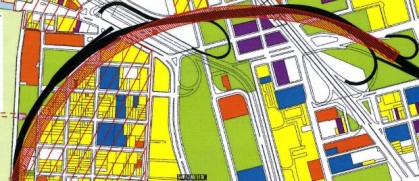Transit blog Mobilizing the Region adds a dose of reality to the controversy over the “Standard Alternative” plan presented by the New York State Department of Transportation at its May 26 BQE EIS stakeholders meeting. That plan calls for the demolition of many homes and land in Willowtown and North Heights area in Brooklyn Heights to bring the road up to federal guidelines.
MtR puts things in perspective:
Mobilizing the Region: In presenting three very preliminary alternatives for the project, the State DOT presented the “Standard” alternative, a concept design that shows the highway alignment if all of the American Association of State Highway and Transportation Officials’ safety and operational standards (for curve radius, lane width, etc.) were applied. Because these standards are largely one-size-fits-all, many are simply inapplicable to an area as built-out as NYC. That said, the Standard alternative provides a useful model by which to measure other (more realistic) alternatives.
Unfortunately, the name “Standard” came off to many members of the public as an adjective, as in “this is the standard way we do things.” Did we mention that the alternative blasts through five blocks of the Brooklyn Heights historic district?
To be clear, the State DOT doesn’t plan to make half the neighborhood homeless, and its efforts to include all relevant stakeholders in the design and review process ought to be commended. But the agency isn’t helping its cause by scaring the living daylights out of everyone in the room.
In response to a TSTC letter gently critiquing their presentation, the project manager admitted, “We discussed various ways to present this information to the [stakeholders committee] and in retrospect probably could have been clearer in what we were trying to convey.” He went on to explain that they chose to err on the side of more disclosure rather than risk appearing to do the planning “behind closed doors.”
The BHA has conveyed the attitude that the NYSDOT is simply doing its due diligence here adding that if a Moses like battle were to come of this they’d “know what to do”. Do you think sitting back like this during the early planning stages is the right strategy? What do you think should be done now that’s not being done? Comment below.



